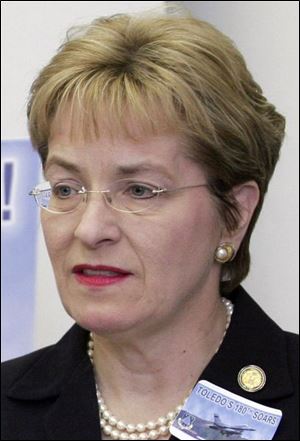
Wind, solar to help fuel 2 National Guard bases
7/24/2007
Kaptur
Two National Guard bases in northwest Ohio could begin to be powered by wind or solar energy by next year, thanks to $7.1 million in federal funding.
The U.S. Department of Defense is investing the money for research and implementation of the renewable energy sources to fuel the Ohio Air National Guard's 180th Fighter Wing, based at Toledo Express Airport, and the 200th Red Horse squadron, based at Camp Perry near Port Clinton, U.S. Rep. Marcy Kaptur (D., Toledo) announced yesterday.
"Toledo can help America become energy-independent again," Miss Kaptur said. "Our country is strategically vulnerable because we import two-thirds of the energy that we use, the petroleum we use. And we're getting it from the most dangerous and undemocratic places in the world."
The University of Toledo's Wright Center for Photovoltaics Innovation and Commercialization will help with the research and implementation.
At the 180th, the plan is to focus on solar energy to power the base, which already has replaced about 20 percent of its streetlights with solar-powered models, Lt. Col. Bill Giezie said.
The idea is to build a ground-mounted photovoltaic array on the base that would convert solar energy directly into electricity, said Robert Collins, interim co-director of the Wright Center and a professor of physics at UT.
The array would be similar to the one at the corner of Dorr Street and Westwood Avenue at UT's alternative energy incubator. However, that array produces 12 kilowatts of energy, and the one planned for the 180th would generate 1 megawatt, Mr. Collins said.
That means the array at the 180th would be about 80 times the size, but the base has acres of land to accommodate it, he said.
"Projects like this, if they can be done at low cost, they're demonstrations that show what can be done on all scales from the small homeowner to the large businesses in the area," he said.
Further east, the 200th at Camp Perry will look at how winds off Lake Erie could help power that base.
The studies will include wind monitoring, wetland evaluation, and avian and bat risks, among other factors.
Based on those findings, the base could install a 600 kilowatt wind turbine. But a back-up plan for solar technologies also will be included in the project, Maj. Michael Hrynciw said.
"This is really a cutting edge project," Major Hrynciw said. "We've done a lot of energy reduction, but now we will be producing energy."
Making these bases energy self-sufficient is a two-part process.
Phase one will evaluate the operational, safety, environmental, and energy requirements of the alternative energy sources. The bases hope to have that complete by the end of the year, paving the way for the second phase in spring or summer of next year in which they would implement the plans, Colonel Giezie said.
Of the $7.1 million in federal funding, $5.1 million is directed to the 180th project and $2 million to the 200th.
Toledo's history in the glass business makes it a natural leader in solar energy production, Miss Kaptur said, adding that not only will these projects help reduce utility costs and our dependence on petroleum, but that this could create new opportunities and new jobs in related fields in northwest Ohio.
"We literally are inventing the future," she said.
Contact Meghan Gilbert at:
mgilbert@theblade.com
or 419-724-6134.